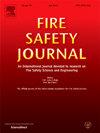Residual load-bearing capacity of large-scale prestressed concrete roof slabs after fire exposure
IF 3.4
3区 工程技术
Q2 ENGINEERING, CIVIL
引用次数: 0
Abstract
Large-scale prestressed concrete (PC) roof-slabs are fundamental structural components extensively used in industrial construction. These slabs have large spans and thin profiles, rendering them susceptible to substantial degradation in load-bearing capacity when exposed to high-temperature fires. Currently, there is a lack of experimental research data on the performance deterioration of such large-scale slabs under high-temperature fire conditions. This highlights the significance of conducting experimental investigations into the fire resistance properties of large-scale PC slabs from theoretical and practical perspectives. In this study, 11 large-scale PC slab specimens were manufactured, with three slabs designated as reference specimens for comparison at ambient temperature. Leveraging a large-scale fire simulation test system, the remaining eight PC slabs were subjected to post-fire residual load-bearing performance tests, considering variations in fire exposure duration and cooling methods. The temperature field distribution during the heating and cooling processes, the deflection deformation characteristics, and the crack distribution patterns after cooling of the PC slabs were observed and analyzed. Furthermore, a comparative analysis was conducted to assess the impact of different fire exposure durations and cooling methods on the degradation of the overall load-bearing performance of slabs. Post-fire static loading tests showed that the slabs retained good overall load-bearing performance after fire exposure. The slabs exhibited the structural characteristics of integrated slab and rib behavior, with the primary rib remaining the key load-bearing component. The overall load-bearing capacity of the slabs after a fire primarily depends on the residual load-bearing capacity of the primary and secondary ribs. Compared to slabs under ambient conditions, the overall flexural stiffness and ultimate load-bearing capacity of the fire-exposed slabs showed varying degrees of reduction. The slabs subjected to natural cooling after different fire exposure durations (30, 45, 60 and 75 min) experienced reductions in ultimate load-bearing capacity by 1.5, 2.3, 4.4, and 15 %, respectively, compared to ambient-condition slabs. For slabs cooled with water, the reductions were 2.8, 6.0, 7.4, and 12.4 %, respectively. The flexural stiffness of slabs cooled naturally after fire exposure was lower than that of slabs cooled with water. The experimental results indicated that large-scale PC slabs exposed to fire for equivalent standard heating times of 24, 39, and 50 min experienced less than 8 % reduction in overall post-fire load-bearing capacity. Therefore, from a load-bearing capacity perspective, large-scale slabs of this type exposed to standard heating for up to 50 min still maintain good load-bearing performance. The findings of this study provide valuable reference data for fire-resistant design, post-fire assessment, and reinforcement of large-scale PC slabs.
大型预应力混凝土屋面板火灾后的剩余承载能力
大型预应力混凝土屋面板是工业建筑中广泛使用的基础结构构件。这些板跨度大,轮廓薄,当暴露在高温火灾中时,它们的承载能力很容易大幅下降。目前,对于这种大型板在高温火灾条件下的性能劣化,缺乏实验研究数据。这突出了从理论和实践的角度对大型PC板的耐火性能进行实验研究的意义。本研究制作了11块大型PC板试件,其中3块作为参考试件,在常温下进行对比。利用大型火灾模拟测试系统,考虑到不同的火灾暴露时间和冷却方法,其余8块PC板进行了火灾后残余承重性能测试。观察和分析了PC板在加热和冷却过程中的温度场分布、挠曲变形特征以及冷却后的裂纹分布规律。此外,还进行了对比分析,以评估不同的火灾暴露时间和冷却方法对楼板整体承重性能退化的影响。火灾后静载试验表明,受火后楼板整体承重性能良好。楼板表现出板肋合一的结构特征,主肋仍然是关键的承重构件。火灾后楼板的整体承载能力主要取决于主肋和次肋的残余承载能力。与环境条件下的楼板相比,受火楼板的整体抗弯刚度和极限承载力均有不同程度的降低。在不同的火灾暴露时间(30,45,60和75分钟)后进行自然冷却的板,与环境条件下的板相比,其极限承载能力分别下降了1.5%,2.3%,4.4%和15%。对于用水冷却的平板,降低率分别为2.8、6.0、7.4和12.4%。火灾后自然冷却板的抗弯刚度低于水冷却板的抗弯刚度。实验结果表明,大型PC板暴露在火中等效的标准加热时间为24、39和50分钟,火灾后的整体承重能力下降不到8%。因此,从承载能力的角度来看,这种类型的大型板暴露在标准加热长达50分钟,仍然保持良好的承载性能。研究结果为大型PC板的耐火设计、火灾后评价和加固提供了有价值的参考数据。
本文章由计算机程序翻译,如有差异,请以英文原文为准。
求助全文
约1分钟内获得全文
求助全文
来源期刊

Fire Safety Journal
工程技术-材料科学:综合
CiteScore
5.70
自引率
9.70%
发文量
153
审稿时长
60 days
期刊介绍:
Fire Safety Journal is the leading publication dealing with all aspects of fire safety engineering. Its scope is purposefully wide, as it is deemed important to encourage papers from all sources within this multidisciplinary subject, thus providing a forum for its further development as a distinct engineering discipline. This is an essential step towards gaining a status equal to that enjoyed by the other engineering disciplines.
 求助内容:
求助内容: 应助结果提醒方式:
应助结果提醒方式:


